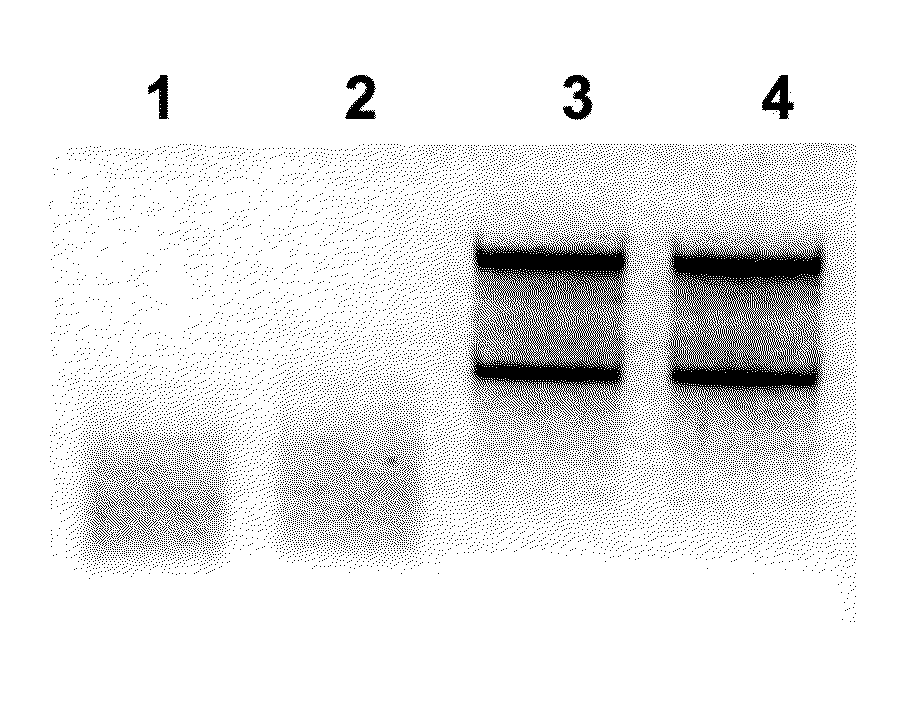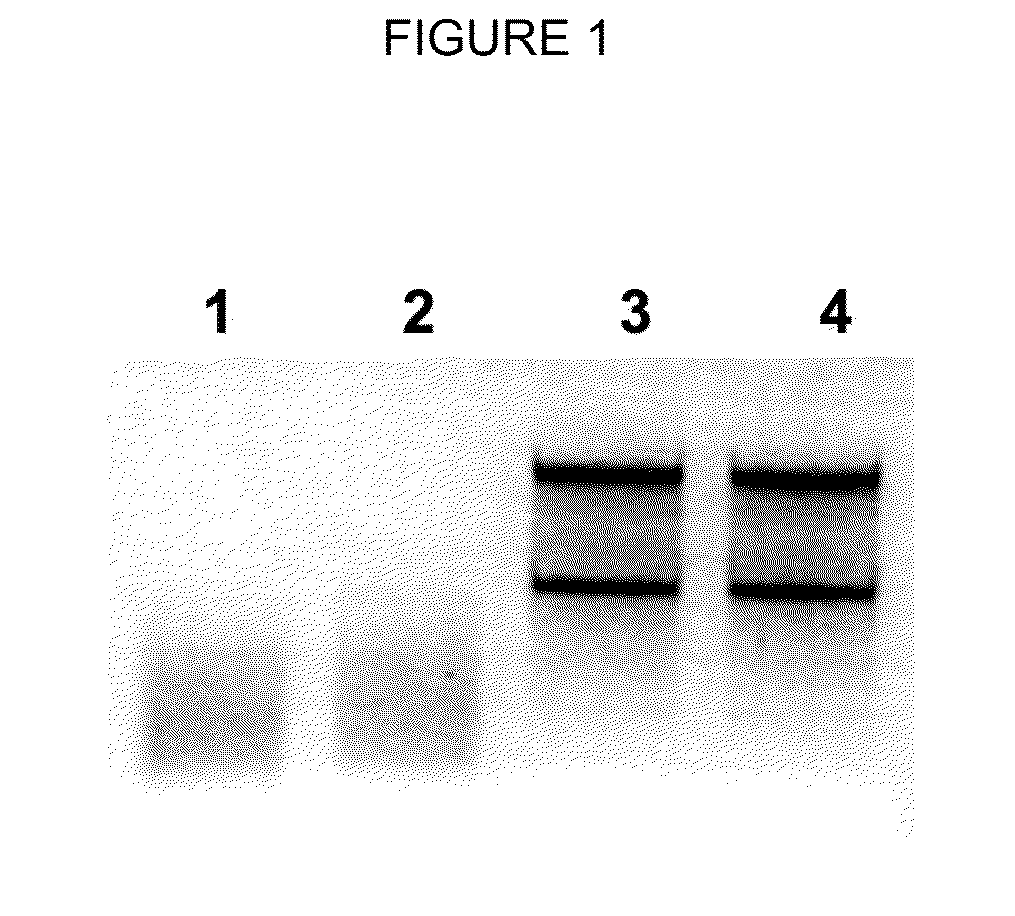For example it is well known that RNA in particular is an extremely labile molecule that becomes completely and irreversibly damaged within minutes if it is not handled correctly.
Certain tissues including the
pancreas are known to be particularly rich in RNase A. RNase A is one of the most stable enzymes known, readily regaining its enzymatic activity following, for example, chaotropic salt denaturation making it extremely difficult to destroy.
There are several methods for inhibiting the activity of RNases such as using; (i)
ribonuclease peptide inhibitors (“RNasin”) an expensive
reagent only available in small amounts and specific for RNase A, B and C, (ii) reducing agents such as DTT and β-mercaptoethanol which disrupt
disulphide bonds in the RNase
enzyme, but the effect is limited and temporary as well as being toxic and volatile, (iii)
proteases such as
proteinase K to digest the RNases, but the transport of proteinases in kits and their generally slow action allows the
analyte biomolecules to degrade, (iv) reducing the temperature to below the enzymes active temperature; commonly tissue and cellular samples are stored at −80° C. or in
liquid nitrogen, (v) anti-RNase antibodies, (vi)
precipitation of the
cellular proteins including RNases,
DNA and RNA using solvents such as
acetone or kosmotropic salts such as
ammonium sulphate, a commercialised preparation of
ammonium sulphate is known as RNAlater™, (vii) detergents to stabilise nucleic acids in
whole blood such as that found in the PAXgene™
DNA and
RNA extraction kit (PreAnalytix GmbH) and (viii) chaotropic salts.
Whilst there are various methods and products that are available to reduce pre-analytical variation, all suffer from various drawbacks making their use problematic or sub-optimal.
Procedures that are effective at stabilising one class of biomolecules are often ineffective at stabilising others so that the
technician is obliged to choose a specialised
reagent and procedure for each
biomolecule analyte.
Generally, commercialised stabilisation reagents for nucleic acids such as RNAlater™, RNAprotect™ or the PAXgene™ stabiliser have the major drawback because the
reagent must be removed from the sample prior to the sample
lysis step.
This is due to the incompatibility of the stabiliser with the
lysis reagents, notably with the
guanidine found in the majority of
lysis reagents.
Inconveniently it is not therefore possible to simply add the lysis solution directly to the sample in the stabilisation reagent.
This problem increases the overall protocol time as extra steps are required but also increases the potential for
contamination between samples when the same pair of
forceps are used to remove the sample, which is commonly the standard method set out in the manufacturer's instructions.
It is also very difficult or impossible to automate the removal of the stabilisation reagent from the biological sample necessitating manual intervention.
Yields are also reduced because inevitably some of the
analyte can not be recovered using
forceps and will be discarded along with the stabilisation reagent and RNAlater™ has the unfortunate effect of causing the tissue to contract and harden making lysis significantly more difficult and therefore RNA yields reduced.
It can also be extremely difficult to use RNAlater™ for stabilising viral nucleic acids in blood, serum and
plasma, and it is not recommended by the manufacturer, again because it is necessary to remove the stabilising solution from the
virus particles after
centrifugation but prior to viral lysis, which can be technically demanding or impossible as the viral
pellets are often not visible and can consequently easily be lost in the stabilisation reagent by aspiration.
Technically this has led to significant problems notably that sample lysis has to be immediately followed by RNA purification which is not always possible or desirable particularly with large numbers of samples, when the
assay is a bDNA
assay or when
automation is involved.
It is not always possible to purify RNA at the time or site where the sample is extracted, for example a
biopsy from a hospital operating theatre or a blood sample from a doctors office.
One of the disadvantages of RNAlater™ is that it only serves for the stabilisation of nucleic acids and not for sample lysis, therefore the
nucleic acid sample has to be physically separated from the stabilisation reagent prior to lysis which is commonly carried out with
guanidine.
At least in the case of the PAXgene™ stabilisation reagent, incomplete removal of the stabiliser will negatively
impact RNA yields during purification (PAXgene™ Blood RNA Kit Handbook, June 2005).
Yeast and
bacteria are generally difficult to lyse due to a robust
cell wall and these samples may need special treatment with enzymes such as zymolase and
lysozyme that are capable of digesting the
cell wall.
Mechanical methods, whilst they are efficient at disrupting tissues, typically lead to heating of the sample due to friction and other processes which can be catastrophic for the quality of the RNA if a guanidine based buffer is used.
Unless care is taken to cool the sample during disruption, the RNA analyte will inevitably degrade.
Whilst the heating step will improve the yield it inevitably leads to lower quality RNA.
Unfortunately it is not all always possible to avoid incubating the mixture of guanidine and lysate, for example some commercialised kit protocols for the extraction of analyte from tissues and in particular viruses require a guanidine heating step in order to improve RNA yield.
Furthermore carrier RNA has a limited
shelf life in the RAV 1
Lysis buffer requiring that it is added shortly before its use.
Cold Spring Harbor University Press, NY) but paradoxically it is rarely, if ever used for storage of biomolecules at ambient temperatures because of its
extremely poor conservation properties unless frozen at −80° C. This has greatly limited its application for use during storage, transport and archiving of biological specimens making it necessary to develop alternative stabilisation mixtures.
The use of guanidine has therefore been generally limited to the lysis and denaturation of a biological sample followed by the immediate extraction of the analyte
biomolecule away from the guanidine solution.
Whilst guanidine is, with good reason, used to inactivate catabolic enzymes such as RNases, the major drawback of its use is that the analyte consequently has to be removed rapidly from the guanidine before
RNA degradation begins.
 Login to View More
Login to View More 

